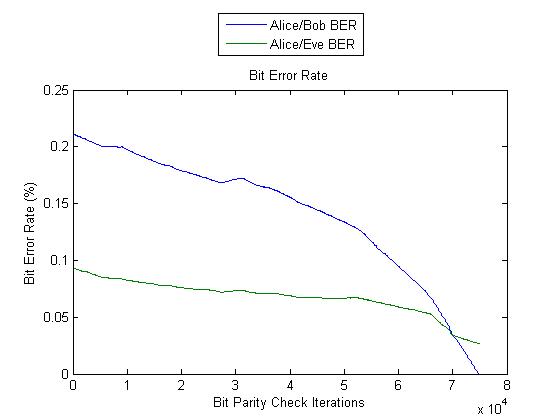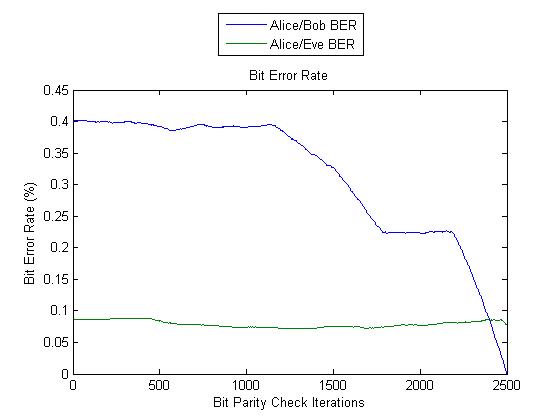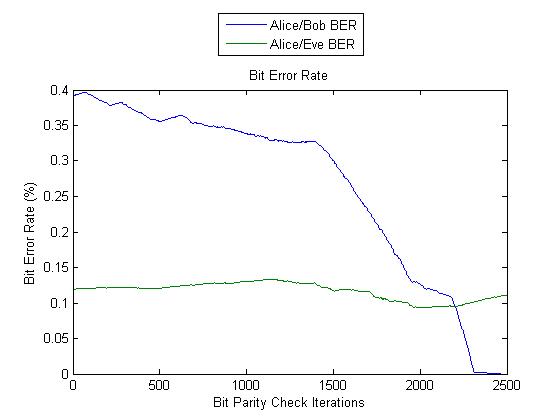Timing Based Encryption: Test Case 1
Test Case 1: Alice, Bob and Eve all on seperate networks[edit]
This test was the simplest of all the eavesdropper tests, and was conducted using three machines - representing Alice, Bob and Eve respectively running three python scripts: AliceTS.py, BobTS.py, EveTS.py. These scripts recorded the round trip times - and these round trip times were subsequently fed into a Matlab file for post analysis. The scripts and Matlab file are available here and here respectively.
Test Run 1[edit]
We notice that in this case, the bit error rates of both of the parties started off very low. However, by the end of the bit parity checks, Bob and Alice had fully reconciled their bit stream, where there was still 5% error in Eve's. This test was actually quite a worst case scenario for us, however, we notice that even in the worst case scenario, the protocol works extremely well. Alice and Bob manage to lower their bit error rates approximately 22% while Eve's only drops approximately 5%.
Test Run 2[edit]
The next test run began with the Alice/Bob bit error rate being at an extremely high 40%, while Eve/Alice started at approximately 10%. This was an successful test run as again Eve's bit error rate did not drop at all by the end of the reconciliation, it in fact rose a little bit, whereas Alice and Bob's dropped an astounding 40% in that time.
Test Run 3[edit]
The next test was run under slightly different circumstances. In this test run, the machines which were running the Alice and Bob scripts heavily throttled their internet connections, and then began downloads/uploads. This was done to simulate the effect which any additional randomness would have on the test results.
The results were positive. In creating an environment which was even more random, the initial bit error rate between Eve/Alice began higher, and actually increased before it decreased. This trend then occured again the end of the reconciliation, where the Eve/Alice bit error rate rose again. In the end, the bit error rate between Eve/Alice rose ever so slightly from the beginning to the end of the reconciliation. While this was happening, the Bob/Alice bit error rate dropped again approximately 40% in the time where Eve's increased.
Summary of Results[edit]
There were other test cases run in addition to the three which are shown here, however, all of the test cases point to the same thing - that when the three parties are on different networks, the protocol functions extremely effectively. Additionally, any source of additional noise and randomness which can be produced is benefitial to the security of the system - this can be in any form, such as the sender and recipient downloading to fluctuate their round trip times, or a sudden routing change.
See also[edit]
- Timing-based key agreement
- Timing Based Encryption: Test Case 1
- Timing Based Encryption: Test Case 2
- Timing Based Encryption: Test Case 3
- Timing Based Encryption: Test Case 4
- Timing Based Encryption: Test Case 5
- Geometric Algebra
- CLUViz Geometric Algebra Animation Software
- Secure communications without key exchange (main page)
- Secure communications without key exchange? 2013 weekly progress
- Proposal Seminar 2013: Secure communications without key exchange?
- Final Seminar 2013: Secure communications without key exchange?
- Semester A Progress Report 2013 - Secure communications without key exchange?
- Semester B Final Report 2013 - Secure communications without key exchange? 2013
- YouTube Videos


